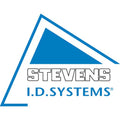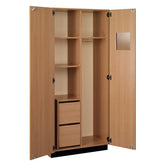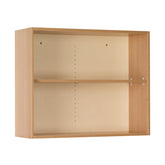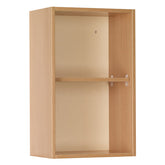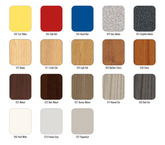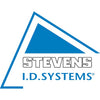Science Classroom Layout: Tips For An Effective Learning Environment
Planning an optimal science classroom layout can be a rewarding challenge for teachers and school administrators. A well-planned science room can enhance students' learning and promote a more engaging experience, but there's more to consider compared to other types of classrooms.
For science teachers, there is an ingrained level of hands-on learning in the classroom that requires a specific set of skills and the proper equipment. The layout of the classroom and the furniture that is used can create a welcoming and engaging learning environment that gets students excited about learning science. Though it is not as simple as just throwing furniture into science rooms and calling it good, there are a few things to keep in mind when designing a classroom to make sure it is optimized for effective learning.
|
Table of Contents |
No matter the grade level, teaching is one of the most impactful jobs on the market. Teachers help bring up the next generation of future business owners, artists, and doctors. It can be a very rewarding job. Though this is not to say that it does not come without any challenges or hard days, the effort is worth the reward of working with students.
Whether you are a school administrator, a new science teacher and beginning to feel overwhelmed, or you are a tenured teacher who just wants to change their science classroom layout, we've got you covered. Below, we will go over key things to consider when planning your space, how to choose the right science classroom furniture, and how to create an engaging learning environment for your students.
What to Consider When Designing a Science Classroom Layout
Creating the perfect science classroom setup can not only make students feel welcome in the space and excited to learn, but it can also enhance the learning experience. It can ensure that students are safe as they navigate science experiments and even facilitate exciting and engaging hands-on learning experiences that students will remember in years to come.
While the aesthetics of your classroom are important for encouraging student engagement and promoting active learning, it is not the only thing that should be on your radar while you are mapping out your room. Some of the factors to consider when designing your science room include the space you have to work with, the safety of yourself and your students, and the accessibility of your classroom space.
Space Planning
One of the first things to keep in mind when designing an engaging learning space is the physical area that you have to work with. Try to figure out the dimensions of your classroom and keep that in mind when creating your layout blueprint. Keep in mind the number of students that will be in the space on a daily basis and design a floor plan that will accommodate those students.
When creating your classroom layout, also have an idea of what activities you plan to do in the space throughout the school year. Different activities have different space needs, and it is important to make sure that you have adequate space to do these activities or have the ability to create that space whenever you need it. If you plan to focus more heavily on group work and lectures, perhaps you could organize your classroom into pods of desks that students can sit in while creating that collaborative learning environment. For science experiments, figure out the space required for each lab and try to design your classroom to accommodate.
If you have smaller square footage to work with, one way you can maximize your classroom space is to create distinct zones that are meant for different activities. For example, you could have one corner of your classroom set up as a demonstration area where you can give visual examples of scientific concepts. You could also invest in lab benches and extra storage to maximize your space while still keeping students engaged.
Safety
The safety of both yourself and your students is a crucial part of designing the layout of your science classroom. Every science classroom should have the standard safety features needed when doing hands-on learning through experiments. These features can include an emergency exit that is easily accessible to students, an eyewash station in the event something harmful gets in someone’s eyes, up-to-date fire extinguishers, and fume hoods if your class does a lot of experiments with chemicals or potentially harmful fumes.
Another safety factor to keep in mind when designing your classroom is that there is adequate space to move around the science classroom tables and other furniture. This can not only make the space feel less cluttered and cramped, but it also helps to keep students safe as they navigate the space. It can help prevent accidents from students bumping into each other as well as keep you safe as you walk around the classroom to aid students while they work on a science lab or experiment.
Accessibility
The third factor to consider when creating an engaging learning environment for students is the accessibility of your classroom space. Try to design your classroom to promote inclusivity, and make sure that each part of the classroom is easily accessible to all of your students. This includes students with any physical or mental disabilities who may need additional accommodations in a classroom setting.
This can include making supplies and equipment easily accessible for all students regardless of physical capabilities, such as having an eyewash station with a lower spout that students in wheelchairs can still easily access.
Science Lab Furniture and Storage
Once you have a general idea of the amount of classroom space you have to work with, shopping for furniture to fill the space can be exciting and get your creativity flowing. Selecting the right furniture and storage options for your classroom is more than just choosing pieces that fit your target aesthetic. It is important to choose furniture pieces that maximize the space available to you while still promoting an open and engaging learning environment for your students.
Choosing the Right Furniture
When choosing the right furniture for your science room, it is important to pick pieces that will work with your classroom setup and your style of teaching. If you enjoy moving your classroom around regularly, then you may want to select pieces that are easy to move and adjustable to fit whatever your current needs are. The standard furniture pieces found in a science classroom include lab benches, stools, desks, and sinks.
The classroom can get chaotic, especially if students are working on an experiment or group project, which is why it is also important to select furniture pieces that are durable and made of the proper materials to withstand in a classroom environment and during experiments. Tables with a phenolic top are common in science classrooms, as the material is made to withstand potentially fire-fueled science labs. It is also easy to clean, making it ideal for a science classroom.
Effective Storage Solutions
Maximizing the storage options in your classroom can help to keep your lab equipment and supplies organized and out of the way. It can also open up more room in your classroom for activities such as labs and group projects. Storage options can include mobile carts, wall cabinets, and tall standing cabinets.
Stevens ID Systems offers multiple storage options that are designed for science classrooms. Our collection of furniture pieces is easy to clean and made of durable materials that can withstand whatever science experiments you throw at it.
Creating an Engaging Learning Environment
The main goal of designing your classroom layout should be to promote a safe and engaging learning environment for students. You could create the most complex and visual experiment you can think of, but if the students do not want to learn they will not engage in the lesson. Try to create an open and welcoming classroom environment that promotes collaboration amongst your students and active participation in the learning process. A classic example is to set up the desks in your classroom into pods or groups where students can engage with each other and work together on group projects and experiments.
Make sure there is a balance between open spaces for easy movement and structured areas to promote focused learning. You do not want your classroom to feel cramped or crowded, but you also want to have enough structure to encourage students to work together and promote collaborative learning. Adding fun decorations throughout the space can also create a stimulating and engaging learning environment that is still calm and not disruptive.
This all sounds lovely, but maybe you need some examples of science classroom furniture pieces to get your creative juices flowing. Stevens ID Systems has a whole collection of science furniture pieces that can maximize your space while promoting student engagement.
We offer phenolic top four student octagon island tables with a sink that creates student pods where they can collaborate and work together on group projects. We also have a whole collection of science classroom cabinets that improve your classroom’s storage and open up more room for activities. Browse our website to shop our entire collection of classroom furniture and storage solutions.
